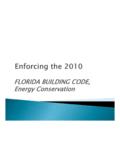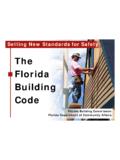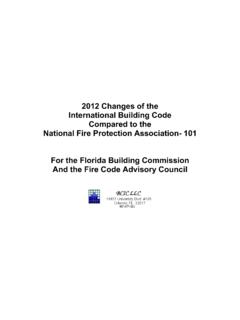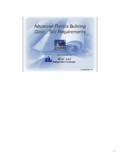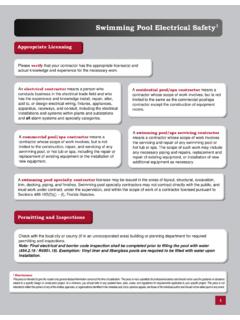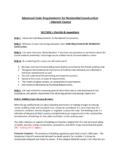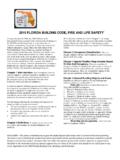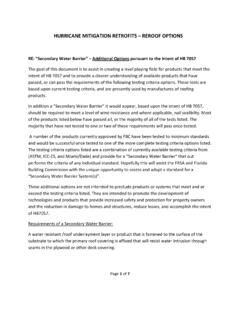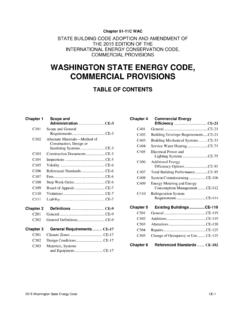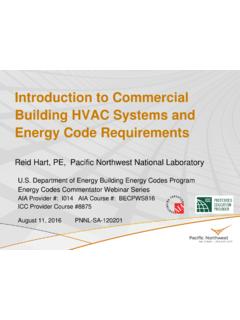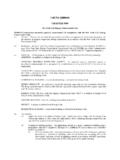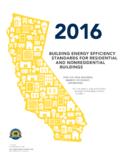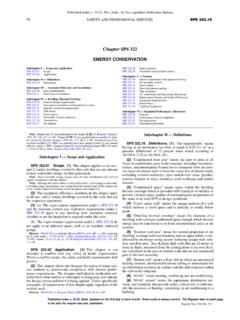Transcription of Comparison of the 6 Edition Florida Building Energy ...
1 Comparison of the 6th Edition Florida Building Energy conservation code with IECC 2018 & ASHRAE FSEC-CR-XXX-18. DRAFT Final Report June 8, 2018. Submitted to Department of Business and Professional Regulation Office of Codes and Standards 2601 Blair Stone Road Tallahassee, FL 32399. Contract No. 132677. Submitted by Bereket Nigusse, Jeffrey Sonne and Muthusamy Swami Copyright 2018 Florida Solar Energy Center/University of Central Florida All Rights Reserved. Disclaimer The Florida Solar Energy Center/University of Central Florida nor any agency thereof, nor any of their employees, makes any warranty, express or implied, or assumes any legal liability or responsibility for the accuracy, completeness, or usefulness of any information, apparatus, product, or process disclosed, or represents that its use would not infringe privately owned rights.
2 Reference herein to any specific commercial product, process, or service by trade name, trademark, manufacturer, or otherwise does not necessarily constitute or imply its endorsement, recommendation, or favoring by the Florida Solar Energy Center/University of Central Florida or any agency thereof. The views and opinions of authors expressed herein do not necessarily state or reflect those of the Florida Solar Energy Center/University of Central Florida or any agency thereof. 1. Executive Summary This study provides a Comparison between the 6th Edition (2017) Florida Building code , Energy conservation (referred to here as the Florida Energy code or FEC) and 2018 International Energy conservation code (IECC), based on approved 2015 to 2018 IECC changes included in the International code Council's Complete Revision History to the 2018 I-Codes document.
3 The Commercial tasks also include a Comparison of changes between ASHRAE and ASHRAE based on addenda included in Standard The first part of the study involved developing commercial and residential code change listings based on the Revision History document that identify changes that have potential Energy and cost impacts. The second part of the study provides a stringency evaluation and cost-benefit analysis for those changes that impact Energy use, to provide guidance for the upcoming 2017 FEC to 2020 FEC. change cycle. The first part of the study has been completed for residential and commercial sections with the submission of the interim report on March 15, 2018 and presentation to the Energy TAC on March 30, 2018. The interim report submission included: (1) Residential 2018 IECC changes with respect to the 2015 IECC and 2017 Florida Energy code , (2) Commercial 2018 IECC.
4 Changes with respect to the 2015 IECC and 2017 Florida Energy code , and (3) ASHRAE. Standard code changes with respect to the 2013 ASHRAE Standard The code change listing and Energy use impact summary are included as part of the appendix in this report for convenience. The second part of this study is to provide a quantitative and cost-benefit analysis for those changes that impact Energy use, and to provide guidance for the upcoming 2017 FEC to 2020. FEC code change cycle. The second part of the project has the following four subtasks: a. Cost Benefit Analysis of moving Residential Energy code from 6th Edition FEC to IECC. 2018 for those items that impact Energy Use b. Quantitative Comparison of Commercial Energy code 6th Edition FEC vs. IECC 2018. c. Quantitative Comparison of Commercial Energy code 6th Edition FEC vs. ASHRAE 2016. d. Cost Benefit Analysis of moving Commercial Energy code from 6th Edition FECC to IECC.
5 2018 & ASHRAE 2016 for those items that impact Energy Use The residential section quantitative and cost-benefit analysis, subtask a, is nearing completion. In this draft report we present the Energy impact of the prescriptive/mandatory changes. The performance changes will be provided in the final report. Commercial section subtasks b, c and d , however, were predicated on DOE developing and providing the state the reference prototype buildings Energy models and economic analyses data, as was indicated in our original proposal. These three subtasks have been awaiting the DOE. releases for some time. The latest indications from DOE (PNNL) are that a portion of the awaited release, namely the ASHRAE 2016 reference Energy code model, are likely to be released in June 2018. The full report containing the economic analysis for ASHRAE code is expected by the end of 2018.
6 Note that there is no firm date or indications from DOE. (PNNL) that the IECC 2018 reference Energy models and analyses will be forthcoming. 2. As a result FSEC proposes modifications to our schedule and budget as follows: (1) since we do not have definite information on whether PNNL will develop the prototype buildings reference Energy code model and analyses for IECC-2018, we propose that FSEC assume that task (subtask b) for an additional budget and schedule, which will be prepared if the Florida Building Commission should approve taking this option; (2) with DOE targeting release of the ASHRAE. work in June, 2018, we proposed to move that part of our effort beyond July, 2018. Subtask c will begin upon receiving the ASHRAE 2016 prototypes from DOE. Subtask d is contingent upon receipt of ASHRAE 2016 analyses from PNNL by the end of the year and the decision on subtask b being assigned to FSEC.
7 FSEC has submitted a revised estimated budget and schedule for subtask b, c and d to Florida DBPR for consideration. This draft final report contains the residential section quantitative and cost-benefit analysis for those changes that impact Energy use that provides guidance for the upcoming 2017 FEC to 2020. The appendix section contains summary of code change listing submitted as part of the interim report and include: Appendix A: Commercial 2018 IECC changes with respect to the 2015 IECC and 2017. Florida Energy code Appendix B: ASHRAE Standard code changes with respect to the 2013. ASHRAE Standard Appendix C: Residential 2018 IECC changes with respect to the 2015 IECC and 2017. Florida Energy code . 3. Contents Executive Summary .. 2. Contents .. 4. Introduction .. 5. Prescriptive and Performance compliance option stringency differences between the 2017 FECC and 2018 IECC.
8 5. Cost Benefit Analysis of moving Residential Energy code from 6th Edition FECC to IECC 2018 for those items that impact Energy Use .. 11. Appendix A: Commercial 2018 IECC Changes Review Summary .. 12. Appendix B: ASHRAE Standard code Change Review Summary .. 60. Appendix C: Residential 2018 IECC Changes Review Summary .. 68. 4. Introduction This project was initiated because the state of Florida desired to compare the 6th Edition Florida Energy conservation code (FECC) with the 2018 Edition of the International Energy conservation code (IECC) and ASHRAE Standard for stringency, and also perform a cost-benefit analysis of updating the 6th Edition FECC to the newer FECC for those elements that impact Energy use. A review of the commercial and residential changes between the 6th Edition (2017) FECC and 2018 IECC which included identification of the changes that had potential Energy and compliance cost impacts was completed for the interim report of this project.
9 The appendix section contains summary of code change listing submitted as part of the interim report and include: Appendix A: Commercial 2018 IECC changes with respect to the 2015 IECC and 2017. Florida Energy code Appendix B: ASHRAE Standard code changes with respect to the 2013. ASHRAE Standard Appendix C: Residential 2018 IECC changes with respect to the 2015 IECC and 2017. Florida Energy code . This remainder of this report summarizes the two remaining project tasks: 1) Use EnergyGauge USA computer simulations to estimate the overall Prescriptive and Performance compliance option stringency differences between the 2017 FEC and 2018 IECC. 2) Provide a cost benefit analysis of moving the residential Energy code from the 6th Edition FECC to the 2018 IECC for those items that impact Energy use. Prescriptive and Performance compliance option stringency differences between the 2017 FECC and 2018 IECC.
10 EnergyGauge USA Energy modeling software approved for 6th Edition FECC compliance calculations was used to compare the overall Prescriptive and Performance compliance method stringency differences between the 2017 FECC and 2018 IECC. Prescriptive Compliance Simulations The Prescriptive simulations compare a 6th Edition (2017) FECC compliant all electric 2,000 sq. ft., 1-story, single-family sample home with the same home that is 2018 IECC compliant in three Florida cities: Miami, Tampa and Jacksonville. Miami represents IECC Climate Zone 1 and Tampa and Jacksonville are both in Climate Zone 2. Outside of a new heated slab insulation requirement1, no Prescriptive changes that affect stringency were identified between the 2015 and 2018 IECC. Two mandatory requirement changes were however identified that apply to all compliance calculations an HVAC register 1.
